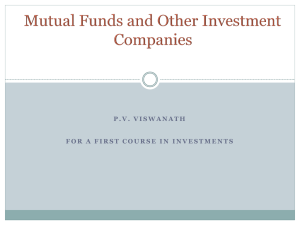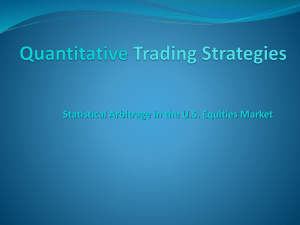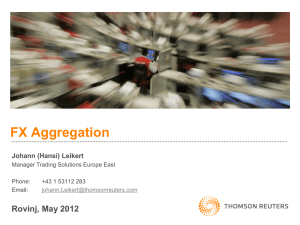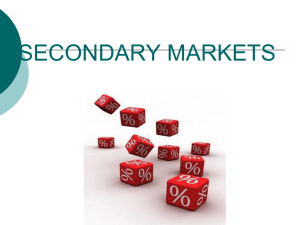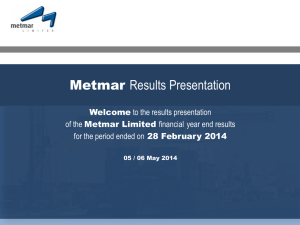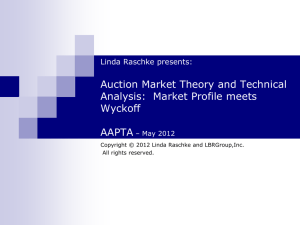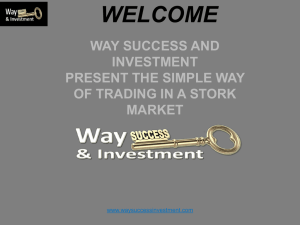HIA – Future Bruce Robinson May
advertisement
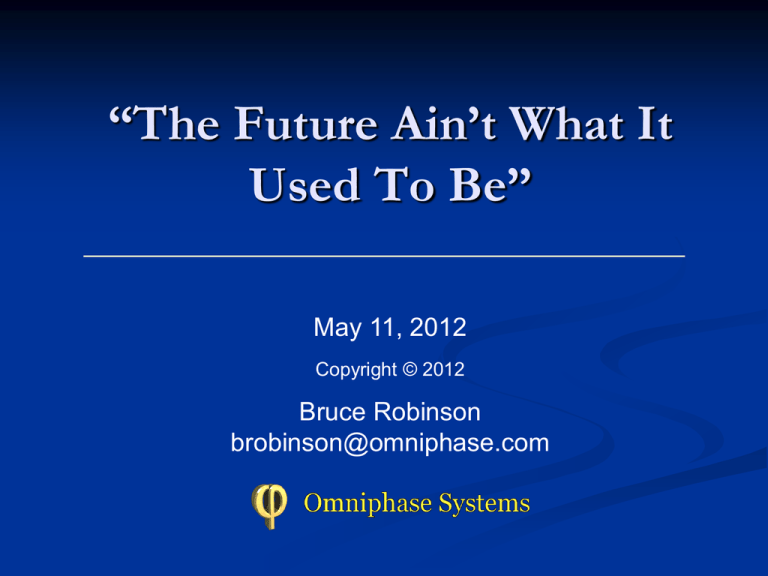
“The Future Ain’t What It Used To Be” May 11, 2012 Copyright © 2012 Bruce Robinson brobinson@omniphase.com Overview Yogi Berra – great American philosopher, baseball manager and player Two famous quotes that are attributed to him “The future ain’t what it used to be” “It’s tough to make predictions, especially about the future” What we want to look at is how the markets and investing have changed over the last decade, and what the future might hold Background and disclaimer Spent 25+ years in hi-tech management, then 10 as a trading system consultant Have been an quant-oriented investor for 25+ years Lessons learned This presentation will be from the perspective of – “Economic (excess) profits” of ALL businesses are eventually claimed by competition Too many “entities” believe their own hype Its hard to identify the real problem when you are consumed fighting the effects An individual investor A consultant to independent advisors and money managers ranging from 15 million to 3 billion Objective – Stimulate thought about trends and issues Offer some examples of what works and what doesn’t today Topics Background – the 1990’s What changed things Availability of computing power to individuals Lower trading cost More fund restrictions New investments and derivatives Internet and high speed networks Democratization of information Bubbles - web companies, real estate, social networking Results related to investing and trading Increased flow of funds and speed of flow Volatility Price noise Decreasing Alpha (return above relative risk to market) Increasing use of Beta (relative risk to market) Topics Truisms Follow the money to find the driving force Systems will always be “gamed” Additional areas to be discussed Trend trading Money managers and independent advisors High frequency trading Opportunities for individual investors Intra-day trading System development and exploration The Good Old Days One way to measure trend is with persistency This is the probability of an up day being followed by another up day, or a down day followed by another down day For small-cap’s, it changed in 2001 At certain times since then, markets have been anti-persistent, and mean reversion strategies have worked well Unfortunately, mean reversion strategies are shorter term trades best executed at the close Computing and Analysis Capability Both computing power and analysis sophistication have steadily increased Machine learning algorithms can now “discover” trading systems Any system can now be optimized and analyzed in minute statistical detail We can measure sensitivity to parameter changes Walk forward premise Walk forward methodology can be used to test optimizations in an out-of sample period that is walked forward in time to see what would have actually happened This would be analogous to looking every month at what route from the Woodlands to south Houston was the fastest with the fewest accidents over the last two years and taking it for the next month BUT the future may not mirror the past Number crunching and visualization "Not everything that counts can be counted, and not everything that can be counted counts." Albert Einstein Measurement depends on when and how you measure Almost all indicators have significant time variation For these reasons, use the following charts with caution – Heat maps Correlation tables In bear markets, correlations of many instruments goes up Try to visualize the relationship as time-varying – patterns will emerge Mutual funds In the 1990’s and early 2000’s, managed funds generated significant Alpha September 2003 – Eliot Spitzer filed against Canary Partners and Bank of America for late trading violations Later charges were made against major fund groups that they allowed market timing in violation of documented policies Market timing became reviled quickly Fund companies then clamped down on trades in and out of their funds, but many refused to publish firm policies Brokerages with fund “supermarkets” became the policing agents Alpha also decreased as funds grew quickly and became more like the market Advisors Registered investment advisors can perform various functions Selection of investments Timing of the market Goal is to meet client targets for return and risk Many fail to achieve one or all of these goals As for bottom line performance – Goal is to avoid bear markets Position size Goal is to out-perform applicable index Must overcome their fee (1.5% – 2.0%) Management expenses of funds (1.25% - 1.5%), ETF’s (0.75%), etc. Advisors also face some logistical challenges May be held to lower trading frequency requirements As they become successful, size limits their ability to perform the three functions Size also limits their ability to service accounts individually ETF’s Total varies depending on the database 1200 is an approximate total Fees are lower than mutual funds Three classes of ETF”s New ETF’s being created Existing ones being terminated Index tracking Pseudo-managed Managed ETF’s Trading volume is key to easy entry and exit Intermediaries, such as Wallach-Beth, exist to facilitate trading of larger blocks But, it is still hard for advisors to trade ETF’s and distribute shares to clients High Frequency Trading This is a very polarizing topic HFT shops are either “predatory scum” Or, they are a “boon” to liquidity and transparency Critics – for example, www.themistrading.com July 9 – the European Parliament votes on new regulatory proposals to force orders to dwell for 500 milliseconds It will be tough to “put the genie back in the bottle” HFT shops are very secretive, but, consider that an example of an algorithm is called the “Disruptor” And, consider a somewhat imperfect analogy – Would you consider an auction where “shills” made bids, then were allowed to withdraw them before the auctioneer recognized them And, the “shills” received rebates from the auction house High Frequency Trading Effects “Noise” has increased But, has volatility really increased ? Depends how you measure it Two standard ways – Average True Range Standard deviation of rates of change The following shows the S&P index as an example Individual Investor Advantages Can make decisions and move money more quickly than advisors Now have tools to trade throughout the day Have access to economic and company information Disadvantages Very difficult to compete at the tick or multi-second level Insider information will always exist Self-reliance is difficult to achieve What’s a conservative investor to do ? One might consider high-yield bond funds as a portion of your portfolio They are relatively easy to time with simple EMA rules Fund managers have the opportunity to contribute Alpha by recognizing companies that will survive and flourish To date, high-yield ETF’s are inferior to mutual funds – IOW, the mutual fund managers are earning their fees But, over time an investor will typically run afoul of trading restrictions of a fund Other good funds can be rotated to in order to minimize timing violations What’s a moderate 401K investor to do ? Many 401K plans allow monthly changes AND have a decent variety of investment choices As an example, here is a system for a company called Sparta that has 18 funds that range from bonds to equity to international funds Simple metrics work as well or better than complex calculations On the last day of the month (this improves results!) rank the funds on – 3 month return 1 month return Volatility (ATR, or alternately SD) Hold the top 2 funds for the coming month What’s an aggressive investor to do ? If one is able to time accurately, you may “buy” volatility (ex. leveraged funds) Ability to short issues or utilize puts can increase returns – but tight control is needed, particularly for mean-reversion trades Stock selection is a way to exploit the account size and agility of an individual investor Some diversification in sectors is needed Knowledge of the macro-economic landscape is helpful and can be used in allocations, but it is very difficult to use it to time investments – it is perhaps better used to guide allocations Tools to scan a candidate stock list are very useful Cheese charts Scanning charts with lines previously drawn for support, resistance, trend, etc. and producing a tabular report The following are just examples – not recommendations Summary The future is here. It’s just not widely distributed yet. – William Gibson – SciFi author We are seeing pieces of the future, but not in the final form Market characteristics have changed and will probably change again Mutual funds have become problematic Advisors will feel increased pressure to show value ETF’s are expanding and still evolving – managed ETF’s are coming High frequency trading may be restricted, but the computer driven strategies will not go away Individual investors have some advantages that can be exploited Investors who evolve their approach with changes that occur will be the most successful What the Future May Hold Remembering what Yogi said “It’s tough to make predictions, especially about the future” With that in mind … Broad market returns will be generally lower Global economic turmoil will create opportunity It will become increasingly hard to time broad markets Selection will play an increasing role for individual investors Automated trading will increase among individual investors Holding periods will become shorter “Edges” will evolve, but will exist for shorter periods of time Contact Bruce Robinson brobinson@omniphase.com 281-576-8857
